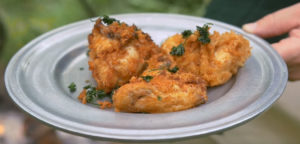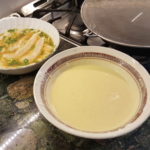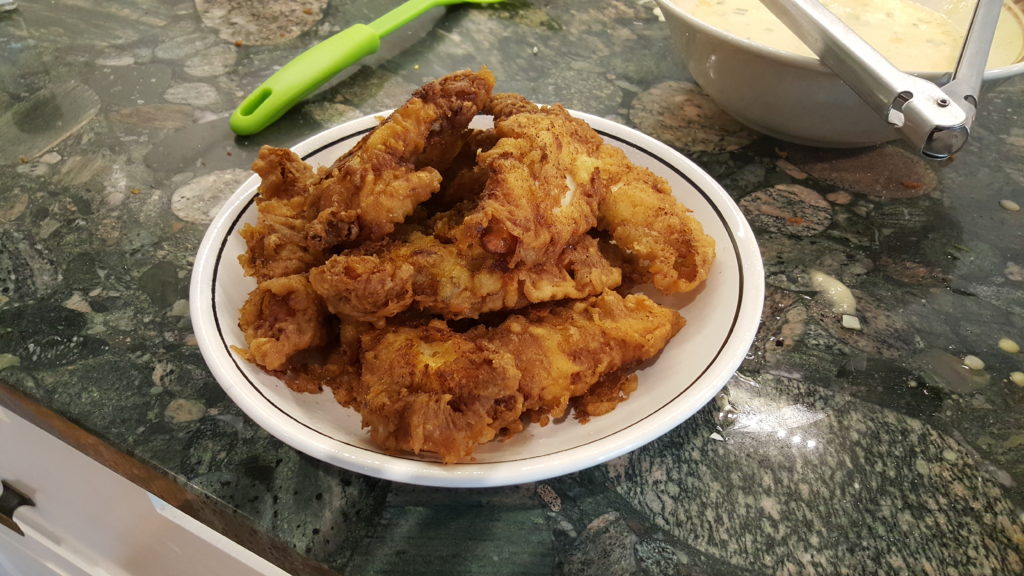
I figured that fried chicken, being a thing that clogs American arteries most aggressively, would be an American invention invented by Americans. (Simplified redundancy intentional.) But to my great surprise, fried chicken — my second favorite thing to eat after BBQ spare ribs — apparently has roots back to Scotland and England. And here’s a video that shows you a step-by-step recipe from the 1736 English cookbook, “Dictionarium Domesticum.”
I defy you to watch that video and not want to make fried chicken. The video is a perfect blend of simplicity, historicity, authenticity, context, and authority. Plus a tri-corner hat!
So, with the sense of urgency that a new discovery like this I cast aside my plans to make some tenders to accompany Giada de Laurentiis’ amazing lemon spaghetti and do some serious 18th century homemade fried chicken.
 The Marinade
The Marinade
The Townsend video recipe for the marinade lists lemon juice, vinegar, salt, pepper, cloves, and bay leaves and a three-hour soak. I ended up going with malt vinegar as my secondary acid, partly because the video suggests this is what they used, but also based on my love for malt vinegar with fish and chips. Although the video suggests a three-hour marinade for chicken parts, I felt two hours would be more appropriate for these tenders. I don’t think I was wrong. The meat had a very malty character after frying which I think suited it perfectly.
 The Batter
The Batter
Batter up! As in the video, I used a cup and a half of all-purpose flour, and some salt. He calls for a fair portion of wine here to thin the flour out and make a pancake-batter consistency, but I forgot to get a box of cheap white wine when I was at the store, so I used white wine vinegar and about a cup of water instead. Needless to say this batter was a tang-fest, and I don’t say that this is a bad thing. Once the egg yolks were added, I couldn’t help but look at this bowl of batter and say “You know, you’re really a thing of beauty.”
The Fry
The video says “use whatever oil you want”. Oh, holy vague advice, Batman! I went with a big honking container of peanut oil, because Google said that its smoke point was good for fried chicken. And it was.
The video doesn’t pretend to give a fry time for the chicken, just advises to keep it in until it’s a beautiful golden brown color. “When it looks like you want to eat it” is probably the best advice you’ll ever get on fried chicken of any kind.
A bit of an aside, this fry made an unholy mess of our cooktop. The problem wasn’t necessarily the oil splatters (that happens) but the slopping of the batter as I transferred the chicken to the skillet. Tenders in the batter ended up stuck together only to divorce in the most ugly way on the way to frying, causing batter splatter and burnt offerings on the cooktop as well as the edge of the pan. This is not the fault of the recipe or anything other than my own inexperience, but it doesn’t mean I don’t feel betrayed.
I’ll admit that I’m a huge paranoid wuss about frying stuff indoors. As much as I adore fried chicken, which is only one letter off from friend chicken, I don’t relish the idea of uncontrollable grease fires that leave me homeless, nor burns that leave me looking like Deadpool. But with the aid of a sturdy iron skillet and a frying thermometer, the frying process went easier than I expected.
The Result
These fried tenders were good, and not just a little. The tenders were crisp and crunchy, without being greasy. The lemon/vinegar brine permeated the tenders thoroughly and added zest to every bite. The white vinegar in the breading made every bite feel like a salty treat, even though I only used a teaspoon of salt in the marinade and a sprinkle in the batter.
I enjoyed every bite, but the real validation came most from my ten year old son, who told me “You have got to make this again.”

